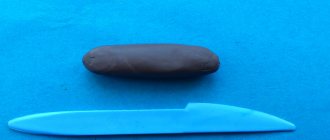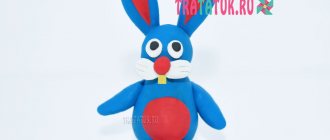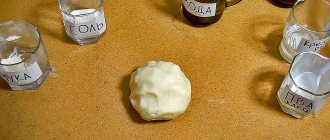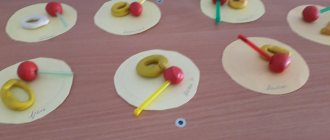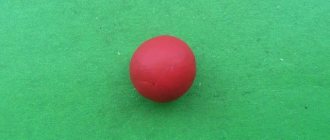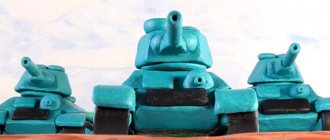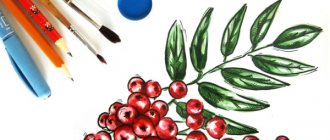How to make a duck from plasticine
Modeling animals and birds is the most popular subject of creative activities, which is due to the wide choice for children's creativity. It is recommended to begin the development of creative skills by sculpting such simple figures as a duck. By gradually performing certain actions, the child will be able to make a bird both independently and with the help of an adult.
A simple duck version
The easiest way to sculpt a duck involves performing the following steps in the prescribed sequence:
- You need to prepare material in brown, burgundy, orange and green. Two large balls are rolled out of dark plasticine, a medium-sized ball from green, and a small ball from yellow.
- The brown ball is the body of the future duck. It is necessary to pull it to one side and press down a little, giving it stability.
- Burgundy material will be needed to make the neck and head. The parts must be connected to each other.
- From drop-shaped blanks made of burgundy and green colors, you need to fashion two wings.
- Using a stack, feathers are drawn on the wings. The wings are glued to the sides of the duck's body.
- Two indentations for the eyes are made on the head: two balls of white plasticine are inserted into the dimples on the head.
- An orange tint will be needed to make a flat beak and, bending it slightly, stick it in the center of the head.
- Once all of the above steps are completed, all that remains is to finish drawing the eyelashes and eyebrows.
Modeling a little duckling
The little duckling is a simplified version of the craft that even a child can handle. Yellow plasticine will be used as a base: the feathers of the chicks are exactly this color.
In order to make a little duckling, you will need to perform the following steps:
- Prepare yellow, white, black and red materials and form small balls.
- The body of the bird, the head, and the wings will be made from yellow plasticine. One piece is divided into three parts, the largest of which will become the body of the duckling, the middle one will become the wings, and the small one will become the head. When ready, the parts need to be connected to each other.
- You need to form a beak from red plasticine and stick it to the center of the head.
- All that remains is to make the eyes from black and white plasticine and attach them to the head.
Duck using natural materials
The use of natural materials is an excellent opportunity to realize the most daring creative ideas.
In order to make a duck from natural material, you will need to prepare:
- Cones
- Plasticine of different colors
- Grass and pebbles
- Blue cardboard
- Glue gun
- Paints and brush
A duck made from cones is a craft for which the child will need the help of an adult:
- From brown plasticine it is necessary to form the head and neck of the future duck.
- The green mass is the plumage of a bird. It is glued to the body blank.
- It is necessary to sculpt a beak from a material of a light brown or mustard shade and fix it in the center of the head.
- The duck's eyes will be made of black and orange material: you need to form two balls of each shade. The black balls should be smaller than the orange ones. Bright flattened blanks are attached to the sides of the head, and black balls are glued to them.
- Red plasticine is for paws. They form and attach to the bottom of the bud.
- You will need cardboard to create the base: you need to cut out an oval.
- Cardboard is an imitation of a lake: grass is placed on one side and pebbles on the other. For reliable fixation, you must use a glue gun. The finished duck can be seated in the middle of the lake: the craft is ready.
Step-by-step instruction
- Prepare the main color for work and the tool. The yellow mass should be thoroughly kneaded in your hands.
- The prepared soft mass can be immediately divided into slices of different formats. The largest piece will be used to sculpt the head, three smaller pieces will be used to create the body and wings of a domestic bird.
- On the ball head, press two triangular holes with a stack. Also knead a small piece of orange plasticine in your hands.
- Insert white cakes into the holes - these will be blanks for the eyes, it is advisable to make them large. Make a beak from an orange piece and attach it to the head.
- Place blue cakes on the white cakes first, then black cakes. After that, add small white highlights.
- Stretch the small piece intended for the body into an oval. Press one side of the oval with two fingers, highlighting the tail. Using the sharp side of the stack, apply stripes to the ponytail.
- Insert a match into the front. Lift the tail slightly up.
- Press the remaining two flatbreads on top onto the board with your fingers. Squeeze on both sides with your fingers, releasing droplets-wings.
- Using a stack, apply the same pattern to the wings as to the tail.
- Glue the wings to the body.
- Prepare orange balls for the paws, press them down with your fingers.
- Make the resulting cakes triangular. Apply 2 strips on each in a stack, highlighting your fingers.
- Attach the legs to the body.
- Add a head to the match.
Children's master class on plasticineography "Fidget Duckling"
Elena Varakina
Children's master class on plasticineography "Fidget Duckling"
Children's master class on working with plasticine “ Fidget Duckling ”
plasticineography technique Hello! Today we, the children of the 2nd junior group No. 5 “Pochemuchki”, want to show you a master class on plasticineography “ The Fidget Duckling ”. Plasticineography is a very interesting and fascinating technique for working with plasticine . It consists in the fact that we paint over the drawing inside the outline not with paints and gouache, but with small balls of plasticine . Also, work can be done not only in the form of gluing small balls onto a drawing, but also by smearing plasticine along the contour of the drawing . plasticineography with great pleasure .
Participants of the master class : Children 3-4 years old and teacher E. N. Varakina.
To create we need:
1. Picture of a duckling with a thick outline
2. Yellow and red plasticine
